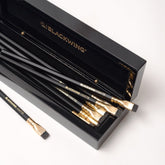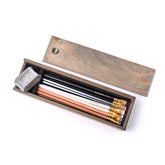History of Native American Ledger Art
The Rich History of Native American Ledger Art
We recently released Volume 574, which is Blackwing’s tribute to Native American art and culture, aligning with and honoring Native American Heritage Month. This is a launch that was especially near and dear to our team. Here’s a further look into ledger books and their rich history.
What is ledger art?
Ledger art is, and has historically been, a form of visual storytelling that dates back to the mid-1800s, originated in Plains tribes. The art primarily focuses on depicting grueling battles, hunting expeditions, intimate courtships, historical events, cultural traditions, and personal narratives.

How did ledger art become an art form?
Plains Native communities documented history through art on any natural canvas they could find, from intricate rock carvings to vibrant buffalo hide paintings.
When settlers arrived many changes occurred, including the near-extermination of the buffalo, and Native Americans were forced to relocate to reservations. With these challenges, Indigenous artists adapted to find new methods to portray storytelling through different creative means such as ledger art.
The unique artistic form and medium of ledger art emerged in the mid-19th century when Plains Native artists began using discarded accounting ledgers as their canvases. The Native artisans drew in these books with pencils, paints, and sometimes crayons, documenting their histories, important stories and more. What was once used to keep inventory of settler property was repurposed to keep inventory of the cultural practices of the people of the Plains. This provided a new way to preserve history and cultural identity.
More than an art form, ledger art is a testament to the resilience and agency of Indigenous peoples in the face of adversity. It’s a visual representation of their unwavering commitment to preserving their cultural heritage.

Why is ledger art important and how is it being preserved to share about Native culture and history?
These expressions of art provide a unique and valuable window into Native American life during a period of immense social and cultural upheaval. It represents adaptation through challenging times. Ledger art is both beautiful and sentimental.
Museums, such as the Smithsonian Institution, the National Museum of the American Indian, and the Newberry Library house significant collections of ledger art. These places play a crucial role in the preservation and education of ledger art. Scholars also utilize ledger art as a way to research and understand the history and culture of Native American tribes.
Ledger art is a way for Indigenous peoples to assert their cultural identity and challenge dominant narratives. The art also provides a shared visual language for communities, helping foster a sense of collective identity and shared history.

The Blackwing 574 ledger book is a recreation of the types of ledger books used by the Plains tribes. We worked with Kaw, Osage, Lakota artist Chris Pappan to design a ledger book that was historically accurate as well as functional. Chris’s current work is focused on ledger art, so we created something that amplified his work and told a unique story in the history of Native American art.



















